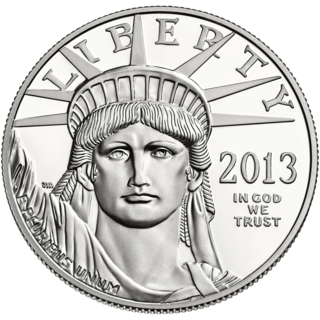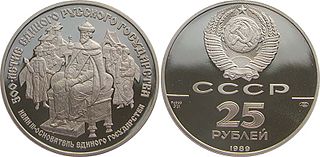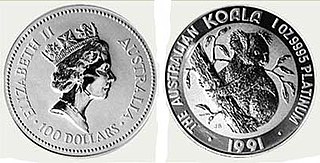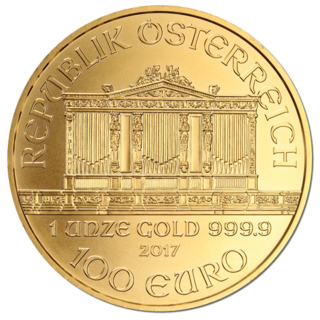Related Research Articles

The Krugerrand is a South African coin, first minted on 3 July 1967 to help market South African gold and produced by Rand Refinery and the South African Mint. The name is a compound of Paul Kruger, the former President of the South African Republic, and rand, the South African unit of currency. On the reverse side of the Krugerrand is a pronking springbok, South Africa's national animal.

Precious metals are rare, naturally occurring metallic chemical elements of high economic value. Chemically, the precious metals tend to be less reactive than most elements. They are usually ductile and have a high lustre. Historically, precious metals were important as currency but are now regarded mainly as investment and industrial raw materials. Gold, silver, platinum, and palladium each have an ISO 4217 currency code.

The Royal Canadian Mint is the mint of Canada and a Crown corporation, operating under the Royal Canadian Mint Act. The shares of the Mint are held in trust for the Crown in right of Canada.
The fineness of a precious metal object represents the weight of fine metal therein, in proportion to the total weight which includes alloying base metals and any impurities. Alloy metals are added to increase hardness and durability of coins and jewelry, alter colors, decrease the cost per weight, or avoid the cost of high-purity refinement. For example, copper is added to the precious metal silver to make a more durable alloy for use in coins, housewares and jewelry. Coin silver, which was used for making silver coins in the past, contains 90% silver and 10% copper, by mass. Sterling silver contains 92.5% silver and 7.5% of other metals, usually copper, by mass.

The American Gold Eagle is an official gold bullion coin of the United States. Authorized under the Gold Bullion Coin Act of 1985, it was first released by the United States Mint in 1986. Because the term "eagle" also is the official United States designation for pre-1933 ten dollars gold coins, the weight of the bullion coin is typically used when describing American Gold Eagles to avoid confusion. This is particularly true with the 1/4-oz American Gold Eagle, which has a marked face value of ten dollars.

The American Platinum Eagle is the official platinum bullion coin of the United States. In 1995, Director of the United States Mint Philip N. Diehl, American Numismatic Association President David L. Ganz, and Platinum Guild International Executive Director Jacques Luben began the legislative process of creating the Platinum Eagle. After over two years of work, the 99.95% fine platinum coins were released by the United States Mint in 1⁄10, 1⁄4, 1⁄2 and 1 troy oz denominations. In late 2008, the fractional denominations were discontinued, leaving only the one ounce denomination. The Platinum Eagle is authorized by the United States Congress, and is backed by the United States Mint for weight, content, and purity.
The Australian Gold Nugget, also sometimes known as the Australian Gold Kangaroo, is a gold bullion coin minted by the Perth Mint. The coins have been minted in denominations of 1⁄20 oz, 1⁄10 oz, 1⁄4 oz, 1⁄2 oz, 1 oz, 2 oz, 10 oz, and 1 kg of 24 carat gold.
The Canadian Gold Maple Leaf (GML) is a gold bullion coin that is issued annually by the Government of Canada. It is produced by the Royal Canadian Mint.

Palladium coins are a form of coinage made out of the rare silver-white transition metal palladium. Palladium is assigned the code XPD by ISO 4217. The first palladium coins were produced in 1966.

Silver may be used as an investment like other precious metals. It has been regarded as a form of money and store of value for more than 4,000 years, although it lost its role as legal tender in developed countries when the use of the silver standard came to an end in 1935. Some countries mint bullion and collector coins, however, such as the American Silver Eagle with nominal face values. In 2009, the main demand for silver was for industrial applications (40%), jewellery, bullion coins, and exchange-traded products. In 2011, the global silver reserves amounted to 530,000 tonnes.
The Canadian Silver Maple Leaf is a silver bullion coin that is issued annually by the Government of Canada since 1988. It is produced by the Royal Canadian Mint.

The American Buffalo, also known as a gold buffalo, is a 24-karat bullion coin first offered for sale by the United States Mint in 2006. The coin follows the design of the Indian Head nickel and has gained its nickname from the American Bison on the reverse side of the design. This was the first time the United States Government minted pure (.9999) 24-karat gold coins for the public. The coin contains one-troy ounce (31.1g) of pure gold and has a legal tender (face) value of US$50. Due to a combination of the coin's popularity and the increase in the price of gold, the coin's value has increased considerably. The initial 2006 U.S. Mint price of the proof coin was $800. In 2007 the price was $899.95, $1,410 in 2009, and $2,010 in 2011.
One of the most profitable aspects of the Royal Canadian Mint (RCM) is its numismatic product line. The first numismatic coin from the RCM was arguably the 1935 dollar commemorating the Silver Jubilee of His Majesty King George V. Though intended for circulation, it was the first Canadian coin commemorating an event. The decision to issue this coin was made in October 1934 by then-Prime Minister R.B. Bennett. There were economic and patriotic motivations for the release of a silver dollar, including a hope to boost the silver mining industry. In future years, the silver dollar would have a more emotional meaning for many Canadians because it was also the first coin to have the Voyageur motif on its reverse.
Since the 1976 Summer Olympics in Montreal, the Royal Canadian Mint has struck Summer and Winter Olympic coins to mark Games held in Canada.
Yvon Gariepy was the President of the Royal Canadian Mint from 1975 to 1981. In later years, he worked for Canada Post. Mr. Gariepy was a professional member of the Order of Engineers of Quebec, Professional Corporation of Urbanists of Quebec, Canadian Institute of Planners and the Institute of the Public Administration of Canada.
The Malaysian Kijang Emas is the official gold bullion coin of Malaysia and is minted by the Royal Mint of Malaysia. It was first issued on 17 July 2001. Malaysia is the 12th country in the world to issue its own gold bullion coin.

The Platinum Koala is an Australian platinum bullion coin minted by the Perth Mint between 1988 and 2000. The Platinum Koala is notionally legal tender, that is a legal means of payment.
A gold IRA or precious metals IRA is an Individual Retirement Account in which physical gold or other approved precious metals are held in custody for the benefit of the IRA account owner. It functions the same as a regular IRA, only instead of holding paper assets, it holds physical bullion coins or bars. Precious metals IRAs are usually self-directed IRAs, a type of IRA where the custodian allows more diverse investments to be held in the account.

The Vienna Philharmonic, often shortened to Philharmonic, is a bullion coin of gold, silver, or platinum produced by the Austrian Mint. The coin is named for the Vienna Philharmonic orchestra, which inspired the design of both sides. It was introduced in 1989 as a one-troy ounce (ozt), gold coin with a face value of 2,000 Austrian schillings. It is generally one of the world's best selling bullion coins. In 2002, with the adoption of the euro currency, the nominal value of the one-ounce coin was changed to 100 euros. In 2008, the Mint introduced a one-ounce silver version of the coin with a nominal value of 1.50 euros. The silver coin is also one of the top selling bullion coins, ranked third in 2013. In 2016, the mint introduced a one ounce platinum coin with a face value of 100 euros.
The Canadian Palladium Maple Leaf is the official bullion palladium coin of Canada. It is issued by the Royal Canadian Mint in .9995 purity. The coins have legal tender status in Canada, but as is often the case with bullion coins, the face values of these coins is lower than the market price of the material they are made from. Unlike the gold, silver and platinum maple leaf series, the palladium maple leaf is subject to the GST/HST tax.
References
- 1 2 3 4 "Platinum Maple Leaf Coin". Royal Canadian Mint. Government of Canada. Archived from the original on October 13, 2014. Retrieved October 14, 2014.
- 1 2 Berman, Allen G. (December 3, 2008). Warman's Coins And Paper Money: Identification and Price Guide. Krause Publications. p. 159. ISBN 9781440221446.
- 1 2 3 4 Rochette, Ed (August 21, 1988). "Canada turns to platinum for Maple Leafs". Chicago Sun-Times. p. 29. Retrieved October 12, 2014.(subscription required)
- ↑ Rochette, Ed (October 15, 1989). "Canada marks Maple Leaf's 10th year". Chicago Sun-Times. p. 13. Retrieved October 12, 2014.(subscription required)
- 1 2 3 4 5 6 "Canadian mint launches silver, platinum coins". Toronto Star. The Canadian Press. September 23, 1988. p. F3. Retrieved October 12, 2014.(subscription required)
- 1 2 "Platinum Maple Leaf launched". Toronto Star. The Canadian Press. November 18, 1988. p. C5. Retrieved October 13, 2014.(subscription required)
- 1 2 McCarthy, Shawn (December 16, 1988). "New platinum coin suddenly not quite so precious". Toronto Star. p. E3. Retrieved October 13, 2014.(subscription required)
- ↑ Royal Canadian Mint (February 5, 2013). "Royal Canadian Mint offers pennies to mark the end of distribution as it launches its latest collector coin offering". PR Newswire. Archived from the original on October 13, 2014. Retrieved October 13, 2014.
- ↑ Aaron, Robert (June 30, 2003). "Golden opportunity for a regal portrait". Toronto Star. p. E7. Retrieved October 13, 2014.(subscription required)
- ↑ Packard, Jimmy (August 15, 1993). "Canadian Mint Introduces New Gold and Platinum Coins". Richmond Times-Dispatch. p. J8. Retrieved October 13, 2014.(subscription required)
- 1 2 "Canadian collector coin sales slump". The Record. Kitchener, Ontario. The Canadian Press. December 7, 1991. p. A12. Retrieved October 14, 2014.(subscription required)
- ↑ "The Platinum Maple Leaf". NWTMint.com. Northwest Territorial Mint. Retrieved October 14, 2014.
- 1 2 "Canadian Platinum Maple Leaf Coins". SBC Gold. Scottsdale Bullion & Coin. Retrieved October 14, 2014.